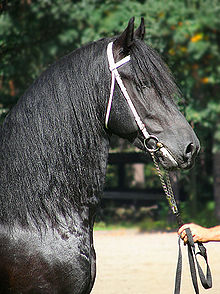- The Emperor Charles (reigned 1516 -56) continued Spanish expansion into the Netherlands, which had its Frisian warhorse, noted by Vegetius and used on the continent and in Britain in Roman times. Like the Andalusian, the Frisian bred true to type. Even with infusions of Spanish blood during the sixteenth century, it retained its indigenous characteristics, taking the best from both breeds. The Frisian is mentioned in 16th and 17th century works... a courageous horse eminently suitable for war, lacking the volatility of some breeds or the phlegm of very heavy ones. Generally black, the Frisian was around 15hh with strong, cobby conformation, but with a deal more elegance and quality. The noted gait was a smooth trot coming from powerful quarters. Nowadays, though breed definition is retained, the size has markedly increased, as has that of most breeds due to improved rearing and dietary methods. --WIKIPEDIA
 The Friesian also remains popular as a carriage horse, as it is a powerful horse and its high-stepping action is eye-catching. It is particularly popular in competitions that require the driving of a team, partly because of its movement and disposition, and partly because it is easy to match teams of black horses. Friesians are also good all-around horses, used for showing, driving, and general riding, and are also used as circus horses.
The Friesian also remains popular as a carriage horse, as it is a powerful horse and its high-stepping action is eye-catching. It is particularly popular in competitions that require the driving of a team, partly because of its movement and disposition, and partly because it is easy to match teams of black horses. Friesians are also good all-around horses, used for showing, driving, and general riding, and are also used as circus horses.Due to its flashy appearance, the Friesian has become popular in the film industry. Though Friesians are of dramatic appearance, sometimes their use in dramatizations of actual historical events is of dubious accuracy, given that the breed as it is known today only came into being within the last 400 to 600 years. The breed owes much of its current popularity to the appearance of the Friesian stallion Goliath (real name: Othello) in the 1985 film, Ladyhawke, which ignited a worldwide interest in these horses. Films such as Eragon, The Mask of Zorro, Alexander, The Chronicles of Narnia, and The Wolfman have also featured Friesian horses. An episode of the TV series Lost featured a Friesian/Saddlebred cross. Most recently Friesians were seen in the 2010 remake of Clash of the Titans, where two horses named "Boech" and "Gallo" each took turns playing the winged horse, Pegasus, and they were also used in the 2011 remake of Conan the Barbarian. --WIKIPEDIA.



















No comments:
Post a Comment